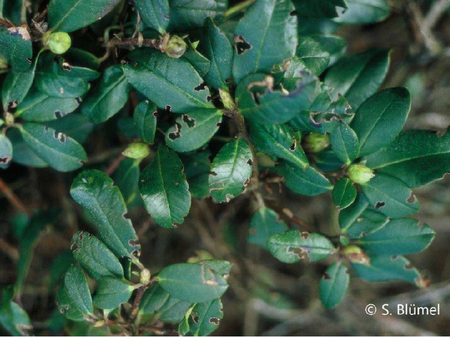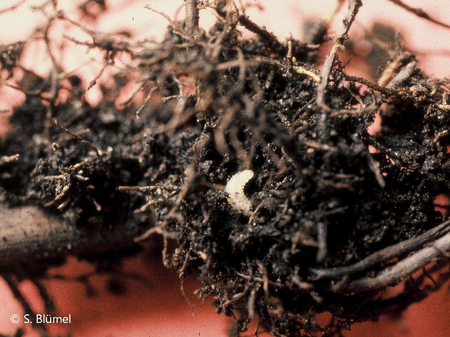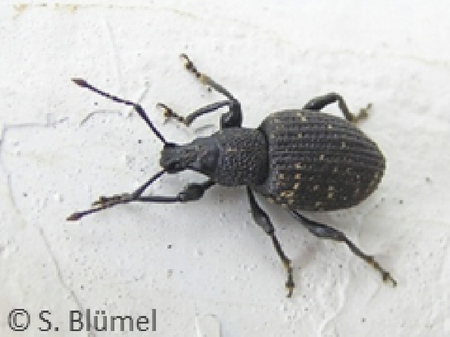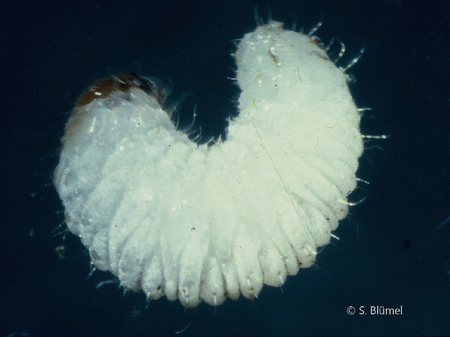Otiorhynchus
Otiorhynchus sp.
Profile
The thick-mouthed weevils(Otiorrhynchus sp.) are a genus of beetles from the weevil family (Curculionidae) that damage roots and above-ground plant parts on soft fruits, vines, and various ornamental plants. Commonly occurring species are the furrowed weevil(Otiorrhynchus sulcatus F.) and the strawberry root weevil(Otiorrhynchus ovatus L.).
Appearance

The adult thickmouth weevils are 1-1.5 cm large, gray-brown to black colored beetles with yellow spots on the coverts(O. sulcatus) on the back, which has longitudinal grooves. The head of the thick-mouthed weevil is extended forward for a long time, forming a broad, flattened proboscis with bead-like formations at the antenna attachment points. The knobbed, club-shaped antennae attach to the center of the head.
The eggs are about 0.7 mm in size, spherical, and brownish.
The beetle larvae , about 1 cm long, are footless, ivory in color, curved on the ventral side, and have a brown head capsule.
The pupae of the largemouth weevil are also about 1 cm long and ivory colored.
Biology
Depending on the species and temperature, the beetles appear from late April to October and usually go through a one-year development cycle in the field. The flightless beetles are nocturnal, hiding in cracks or crevices of plants or in the soil during the day and feeding on above-ground plant parts.
Beginning in late May, female beetles lay several hundred eggs on the root necks of host plants in the soil or under plant debris over a period of two to three months, from which larvae hatch after about 14 days. From the end of August, the young larvae can be found in the soil of the root zone or in the rhizomes of the infested plants.
The beetle larvae overwinter after brief feeding in the root zone and pupate after maturing in the following spring from the end of March. After a pupal dormancy of three to six weeks, the adult beetles emerge.
There may be deviations from the one-year development cycle, because in the open field, depending on the temperature, two-year development cycles occur in some species of thick molars, or because in the greenhouse or conservatory, adult beetles can overwinter in addition to the larvae. Therefore, under certain circumstances, several developmental stages of the pine weevil can occur simultaneously throughout the year.
Damage symptoms
The beetles cause the typical, mostly insignificant, bay-shaped leaf edge feeding on aboveground plant parts, but pitting and sensitive feeding damage to shoot tips and peeling feeding on young shoots on the buds.
The main damage is caused by the larvae feeding on the underground parts of the plant, the roots or rhizomes, which leads to the destruction of the roots and subsequent wilting symptoms and even the death of the infested plants.



Host plants
Chiggers occur on approximately 150 host plant species and infest grapevines, bush fruit, strawberries, and ornamentals, especially various container plants and nursery stock such as yews(Taxus), rhododendrons, cherry laurels, privet, and dwarf loquats(Cotoneaster), as well as cyclamen in greenhouses.
Prevention and control
- Only infestation-free planting material should be planted (check root balls for larval stages in nursery stock!).
- Perennial strawberry crops or multiple planting of strawberry crops in succession on the same area should be avoided.
- Control of adult beetles is difficult and usually ineffective because of the long hatching period from the pupa and because of the hidden lifestyle of the nocturnal beetles.
- Optimal control is directed against the larvae. Treatments should be carried out in the field in spring (mid-April to late May) or in autumn (September to mid-October) for a one-year development cycle, or in both periods for heavier infestations.
- For biological control, insect-pathogenic nematodes(Heterorhabditis sp., Steinernema sp.) or insect-pathogenic fungi(Metarhizium anisopliae) are suitable (see list of plant protection products approved in Austria).
- Chemical control is currently only approved for pot and container plants in ornamentals.
Specialized information
Publications
Blümel, S., Kaserer, H., 1989. studies on the control of Otiorrhynchus sulcatus F. on vines and ornamental plants, Mitteilungen Klosterneuburg, 39, 124-129.
Blümel, S., 1989. is it possible to successfully control "thickmouth weevils"? New Harvest, 3, 10-11.
Blümel, S., 1989. autumn control of the thick-mouthed weevil on strawberries. Better Fruit, 34(9), 251-252.
Blümel, S., 1989. is it worthwhile to use Heterorhabditis nematodes against largemouth weevils? Horticultural Economics, 44(8), 14-15.
Last updated: 04.09.2023
automatically translated


